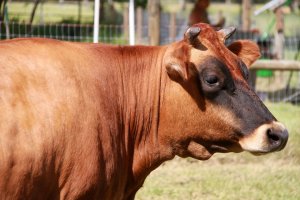How Much Milk Does a Beef Cow Produce Per Year


If you have been searching for the right beef cattle breed for your new farm, you undoubtedly have come across plenty of promotional literature published by breed organizations. This material usually includes long lists of the benefits of the breed in question, such as calving ease, rapid weight gain, or meat tenderness.
One characteristic commonly touted is a cow's milk production. This may give you pause if you are not looking for dual-purpose cattle. After all, what difference does it make if a beef breed is noted for milk production?
Benefits of High Milk Production in Beef Cattle
By producing plenty of milk, a beef cow is producing plenty of food for her calf. The more food the calf has access to at an early age, the heavier the calf will be by weaning time. A study conducted by Oklahoma State shows that the extra milk can translate into as much as 30 extra pounds of calf weaning weight. All other factors being equal, heavier calves tend to bring better prices at sale time.
Drawbacks of High Milk Production in Beef Cattle
All this said, there are reasons why some beef producers still look for more moderate levels of milk production in their cows. When nutrient inputs are limited, cows will channel their energy into three basic directions:
- Body maintenance.
- Lactation.
- Reproduction.
Each of these functions represents a separate "level." Only if the demands of one "level" are met will surplus energy be channeled into the next level. So lactation will only occur after the body's basic maintenance needs are met, and the cow will only breed again after she has met her energy requirements for lactation.
Not surprisingly, cows that are heavy milkers need plenty of energy. They require large feed inputs to output all the milk they are capable of producing, and only once their nutrient needs for lactation are met will they be ready to breed again. Heavy-milking cows rarely thrive in a low-input, grass-based system. They tend to form the lowest tier of the herd, the ones that always breed back late. Oklahoma State research shows that heavy-milking cows also tend to have poorer body condition than their lower-milking counterparts.
Choosing the Right Cows For You
As you can see, when considering beef cows based on their milk production, you have to strike a delicate balance. Higher milk production means a heavier, more valuable calf, but it also means a less reliable, more expensive cow.
If you are looking at a grass-based system, you may simply not have the option of using heavy-milking beef cows. If you are planning on providing some supplemental feed, then you will have to count the cost.
Estimates of the dry matter intake of different cows in early lactation are as follows:
- Cows that produce 10 pounds of milk per day: 26.5 pounds of dry matter per day.
- Cows that produce 20 pounds of milk per day: 29.0 pounds of dry matter per day.
- Cows that produce 30 pounds of milk per day: 31.5 pounds of dry matter per day.
Do you have access to an abundant supply of cheap feed? That may decide whether a heavy-milking cow will be an asset or an expense in your system. Keep in mind, however, that you can maintain more low-milk-production cows than heavy-milking cows on the same amount of feed.
Do the math!
Source: https://homesteadontherange.com/2017/03/14/milk-production-in-beef-cattle/
Post a Comment for "How Much Milk Does a Beef Cow Produce Per Year"